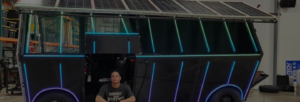Off-Grid Power – Air Conditioners Solar power and lithium battery technology have revolutionized the way...
Read MoreRV Solar 101: Batteries (Part 3)
Mobile power systems are only as good as the batteries that hold the power.
RVs typically use deep cycle, valve-regulated lead-acid (VRLA) batteries that can be regularly discharged and recharged. There are two types of VRLA batteries— gel and absorbed glass mat (AGM)—with the latter being more popular.
AGM batteries offer many advantages to the RVer. They are sealed, do not spill or vent gas, and require no maintenance. AGM batteries also charge quickly and are more resistant to low temperatures. They are, however, sensitive to overcharging and require the use of a charge controller as a preventative measure.
Gel batteries are also sealed and don’t spill, but they are much slower to charge than their AGM counterparts. Based on older technology, they also require a charge controller compatible with Gel batteries.
Lithium batteries. The third option not mentioned above is lithium batteries. They provide high performance and efficient charging in a low-weight package. They are safe, require no maintenance, and offer a long life-cycle. The drawback to lithium batteries is cost—these batteries come with a high price tag.
How many batteries will I need? This will depend on the energy consumption of your RV. The more appliances you plan to run, the higher your consumption will be. RV batteries can also be wired together to form a ‘battery bank,’ providing either higher voltage (wired in series) or greater capacity (connected in parallel).
Should I choose 6v or 12v batteries? While 6v batteries offer more amp hours, 12v batteries, in some configurations, can provide more redundancy.
Most of your RV applications require 12v current, so you’ll need two 6v batteries connected in series to generate those 12 volts. If one of those 6v batteries go bad, you’ll have no usable power.
However, if two 12v batteries are connected and one does not work, you’ll still have usable 12v power.
Typically, 6v batteries are used if you’re looking for maximum power or are planning to have a large battery bank.
Buying tips
- For most off-grid applications, high-quality AGM batteries are preferred since they strike the best balance between performance and price.
- Lead-acid batteries cost less up front. They also need to be maintained to keep them running at peak performance, and have a shorter lifespan.
- Lithium batteries are more expensive up front. However, they are higher efficiency, maintenance-free, and have a longer lifespan.
- Be sure to check out the manufacturer’s battery warranty and ask about their service and support capabilities.
HOW SOLAR WORKS – QUICK LINKS
LATEST NEWS
Watch product troubleshooting videos, read the latest in company updates, and stay up-to-date on trade-shows and events.
Creating the Ultimate Solar-Powered Car
Few people have a more diversified portfolio when it comes to custom car builds than...
Read MoreGo Power! Wins Gold in
Go Power! Wins Gold for Favorite RV Solar Product in the 2024 Wildsam Reader’s Choice...
Read More
STAY UP TO DATE
Get news, product specials, and event invites directly to your inbox.







